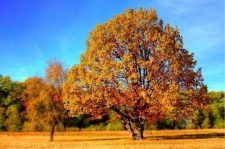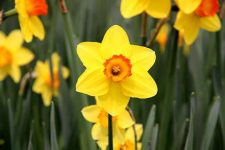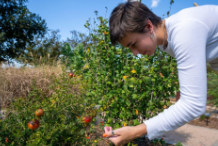ANNOUNCEMENTS
This Week’s K-State Garden Hour Webinar: Xeriscaping: Beautiful Landscapes with Less Water, Wednesday, May 19th; Noon – 1:00pm CST Presented by: Ariel Whitely-Noll, Shawnee County Horticulture Extension Agent. Join this free gardening webinar the first and third Wednesday of every month. Recordings are made available online, and a one-time registration is required participate in the live webinar series. To register, see upcoming webinars, and view previous webinars, visit: http://ksre-learn.com/KStateGardenHour
REMINDERS
- Break up crust on soil of vegetable garden after heavy rain to allow roots to breathe.
- No need to spray for cedar-apple rust after Memorial Day
- Don’t work soil too wet. Squeeze a handful of soil and push your finger into the soil. It will crumble if it is dry enough to work.
- Take care of weeds when they are small as they are easier to control and will not compete with your vegetables or flowers. Consider using a scuffle hoe as they are quick to use and are less likely to bring weed seeds to the surface.
VEGETABLES
Walnut Wilt
Tomato, potato, blackberry, apple, lilac, asparagus, chrysanthemum, peony, and other herbaceous and woody plants can be afflicted with a disorder known as walnut wilt. Other plants, such as black raspberry, corn, bean, carrot, dandelion, and zinnia are resistant. This malady is associated with root uptake of a chemical called juglone that is produced by several species of trees in the walnut family, including black walnut, Persian walnut, butternut, and pecan with black walnut producing juglone in the highest amounts. Juglone is formed in the leaves, fruit hulls, inner bark, and roots of the walnut and is leached or released into the soil. This chemical has fungicidal and insecticidal properties. It also is quite toxic to many plant species and induces wilting and stunting. The ability of plants to produce and release chemicals that are toxic to other plants is called allelopathy. The severity of the juglone toxicity partly depends on the proximity of the plants to a walnut tree. - Generally, tomatoes growing next to a walnut tree abruptly wilt and die in early to mid-summer. Those plants growing a short distance away may not be killed but become flaccid and stunted. The woody stem tissue of affected plants turns brown. The symptoms of walnut wilt closely resemble those of Fusarium and Verticillium wilt, but the disorder may be distinguished from the other wilts by the constant association of walnut trees with the wilting symptoms.
- Juglone may be leached from leaves and nuts into the soil during rain or released from roots. The chemical is highly reactive and quickly inactivated in the soil. The major uptake of the toxin occurs when tomato roots make contact with the roots of the walnut.
Tomatoes or other susceptible plants should not be grown near black walnut or other trees that produce juglone. The removal of walnut trees may not have an immediate effect because the toxin can persist in the inner bark of roots for several years. Do not plant tomatoes for at least two years after removing walnuts. (Ward Upham)
Colorado Potato Beetle
Overwintering females usually emerge in late April and lay a cluster of bright, yellow eggs on recently emerged potato plants. Larvae mature in about 3 weeks and pupate in the soil. After another 10 days, adult beetles emerge, mate and lay more eggs.
Both larvae and adults of this insect feed on potato (as well as tomato, eggplant, and pepper), causing extensive loss of foliage and reducing yields. Control strategies are varied and include:
- Hand picking: Useful for small gardens where plants can be checked a couple of times a week. Dropping beetles and larvae in a container of soapy water will lead to their demise.
- Floating row cover: This material can be placed over the planting and act as a physical barrier to the insects. Be sure to seal the edges. It is sometimes suggested to leave the floating row cover in place during the growing season because potatoes do not need to be pollinated to produce tubers. Often, this is not practical because it interferes with weed control.
- Insecticides: A number of products are registered including spinosad (Captain Jack’s Dead Bug Brew, Bonide Colorado Potato Beetle Beater Concentrate, Monterey Garden Insect Spray) and permethrin (Eight Vegetable, Fruit & Flower Concentrate, Hi Yield Garden and Farm Insect Control). (Ward Upham)
FRUIT
Remove Blossoms on Newly Planted Strawberries - Spring-bearing strawberry plants that were set out this spring should have blossoms pinched off. New plants have a limited amount of energy. If blossoms remain on the plants, energy that should go to runner development is used to mature fruit instead. Plants that are allowed to fruit will eventually produce runners, but those runners will not be strong enough to produce a good crop of berries the following year. For an adequate strawberry plant population and a good crop next year, early runner development is necessary. Early runners will produce far more strawberries than runners that form later in the season.
Newly planted everbearing plants also should have fruits removed for the first 4 to 6 weeks after planting so they develop a strong root system. (Ward Upham)
Thinning Excess Fruit
Late freezes this year have limited fruit bearing. I have lost crops on peaches and apricots and some other parts of the state have lost pears. An overabundance of fruit on a tree may seem like a good thing, but too many fruit can cause problems that should be alleviated by removing the excess (thinning). For example, a heavy fruit crop can interfere with fruit bud development this summer. This can result in a small to no crop next year. This problem most often appears with apples. Thus, thinning helps ensure that good crops are produced each year.
The second benefit of thinning is to promote larger fruit on this year’s crop. Fruit trees are limited in how many fruit they can mature. Too many fruit and fruit size and quality goes down.
A third problem often caused by too many fruit is limb damage. Sometimes the weight of a maturing fruit crop can literally break branches. Thinning will help limit weight and preserve branches.
So how much thinning should we do? Thinning recommendations vary with the type of tree.
Apples and pears: 6 to 8 inches apart. Apples tend to produce fruit in clusters of five. We usually remove all the fruit in a cluster but one. Leave the largest, nicest fruit in the cluster. However, there are times you must remove perfect apples.
Peaches: 6 to 8 inches apart. Peaches tend to cluster together. As long as the average is about 7 inches apart, you will be fine.
Plums and prunes: 4 to 5 inches apart;
Apricots: 2 to 4 inches between fruit.
These are averages and so you may have several fruit clustered closer than this distance. As long as the average on the branch is close to the recommended spacing, the fruit should size well.
Thinning can be done by snapping them off by hand or by cutting them off. If snapping them off by hand, support the fruit stem with your thumb and forefinger and use your other fingers to snap them off. This can be done with one hand with a little practice.
Cherries are not thinned and can produce a full fruit load. (Ward Upham)
TURF
Too Wet to Mow the Lawn
What do you do when the lawn can’t be cut because of constant rain? The best thing to do is to set your mower as high as possible and bring it down in steps. It is always best never to take more than one third of the grass blade off at one time. If more is taken, the plant reacts by using stored energy reserves to quickly send up new growth. This reduces the amount of energy available for the plant to deal with stress or damage done by insects or disease. However, sometimes it is just not possible to keep the “one-third rule.” In such cases, cut as high as possible even though it may mean you are cutting off more than one third of the blade. Bring the height down gradually by cutting more often and at progressively lower heights until you reach the target height. (Ward Upham)
Time to Fertilize Warm-Season Grasses
June is the time to fertilize warm-season lawn grasses such as bermudagrass, buffalograss, and zoysiagrass. These species all thrive in warmer summer weather, so this is the time they respond best to fertilization. The most important nutrient is nitrogen (N), and these three species need it in varying amounts.
Bermudagrass requires the most nitrogen. High-quality bermuda stands need about 4 lbs. nitrogen per 1,000 sq. ft. during the season (low maintenance areas can get by on 2 lbs.). Apply this as four separate applications, about 4 weeks apart, of 1 lb. N per 1,000 sq. ft. starting in early May. It is already too late for the May application, but the June application is just around the corner. The nitrogen can come from either a quick- or slow-release source. So any lawn fertilizer will work. Plan the last application for no later than August 15. This helps ensure the bermudagrass is not overstimulated, making it susceptible to winter-kill.
Zoysiagrass grows more slowly than bermudagrass and is prone to develop thatch.
Consequently, it does not need as much nitrogen. In fact, too much is worse than too little. One and one-half to 2 pounds N per 1,000 sq. ft. during the season is sufficient. Split the total in two and apply once in early June and again around mid-July. Slow-release nitrogen is preferable but quick-release is acceptable. Slow-release nitrogen is sometimes listed as “slowly available” or “water insoluble.”
Buffalograss requires the least nitrogen of all lawn species commonly grown in Kansas. It will survive and persist with no supplemental nitrogen, but giving it one lb. N per 1,000 sq. ft. will improve color and density. This application should be made in early June. For a little darker color, fertilize it as described for zoysiagrass in the previous paragraph, but do not apply more than a total of 2 lb. N per 1,000 sq. ft. in one season. As with zoysia, slow-release nitrogen is preferable, but fast-release is also OK. As for all turfgrasses, phosphorus and potassium are best applied according to soil test results because many soils already have adequate amounts of these nutrients for turfgrass growth. If you need to apply phosphorus or potassium, it is best to core aerate beforehand to ensure the nutrients reach the roots. (Ward Upham)
MISCELLANEOUS
Three Steps to Choosing Potting Media for Outdoor Use: Part 1
I have had several questions this spring on potting soils and how to choose the best potting media. Dr. Cheryl Boyer, our Nursery Crop and Marketing Specialist, has done extensive studies on potting soils and has written the following to help homeowners make a good choice. We will present her material is three parts or steps with one step each week.
Step 1: What are You Using it For?
Step 2: Understanding Major, Minor, and Specialty Components
Step 3: Mixing and Managing
So, here is this week’s post. (Ward Upham)
There are a lot of choices in the potting media aisle of your local garden center. If you don’t know what you’re looking for, it can be a confusing experience to read the label.
Fortunately, there are three easy steps/considerations for screening the available choices down to one that works for your needs.
Step 1: What are You Using it For?
It does make a difference whether you are planning to use media in a container or as a soil amendment in a raised vegetable bed or landscaping bed. Some materials are designed to hold water well while others are designed to drain well. What do you need for each of those situations?
Growing plants in containers: Generally, you want to use a peat-based soil-less substrate for this application. Do not use field soil. These products are engineered for success in season-long growth of annual plants in containers of reasonable size for consumer use (very large containers are a different discussion). Peat-based mixes almost always have a “starter charge” of fertilizer mixed in to get your plants growing, but you’ll need to supplement with fertilizer as the season progresses. Old potting media has likely lost its starter charge and may, in fact, become hydrophobic (repels water) over time. You’ll need to spend some time rewetting and mixing old potting media for a new season if you intend to re-use it.
Amending a landscape bed or raised bed: Products containing peat should not be the primary component but are acceptable in small quantities. Field soil mixed with compost and perhaps a coarse pine bark-size material is best in this situation. The objective is to enrich your existing soil with natural material that will break down over time and in the meantime provide nutrients and aeration for roots to grow well. Make sure to apply the material and mix/till it into a broad area and not just a single planting hole or your new plants may experience the “soup bowl effect” and succumb to rapid decline. Check with your local landscape contractor to get a large volume of soil delivered, perhaps even mixed with compost from a local municipal composting facility. (Cheryl Boyer)
Helping Roundup (Glyphosate) Products Work Better
Though glyphosate products (Roundup, Killzall, Pronto Weed & Grass Killer) are non-selective and will kill most plants the spray contacts, these herbicides are not taken up by the roots of nearby desirable plants. This is because the active ingredient is neutralized when it contacts the soil due to being tightly bound to soil particles. Unfortunately, this binding effect can also take place in hard water that is high in magnesium and calcium, which reduces its effectiveness. To avoid this, mix ammonium sulfate with your spray water before adding the glyphosate product. The ammonium sulfate ions tie up the calcium and magnesium ions so that the glyphosate remains at full strength. Also some of the glyphosate will form a compound with the ammonium that weeds will more readily absorb, thus increasing effectiveness.
Note that this binding effect takes place in hard to very hard water (above 7 grains or above 120 ppm). Adding ammonium sulfate to softer water will not help. So if you have your water tested and find you have hard water, how much ammonium sulfate should you add? As a general rule, add 8.5 pounds per 100 gallons. This would equal about 1.4 ounces per gallon or four tablespoons per gallon. (Ward Upham)
Contributors: Cheryl Boyer, Nursery Specialist; Ward Upham, Extension Associate
Division of Horticulture
1712 Claflin, 2021 Throckmorton
Manhattan, KS 66506
(785) 532-6173
For questions or further information, contact: [email protected] OR [email protected]
This newsletter is also available on the World Wide Web at: http://hnr.k-state.edu/extension/info-center/newsletters/index.html
The web version includes color images that illustrate subjects discussed. To subscribe to this newsletter electronically, send an e-mail message to [email protected] or [email protected] listing your e-mail address in the message.
Brand names appearing in this newsletter are for product identification purposes only. No endorsement is intended, nor is criticism implied of similar products not mentioned.
K-State Research and Extension is committed to making its services, activities and programs accessible to all participants. If you have special requirements due to a physical, vision or hearing disability, or a dietary restriction please contact Extension Horticulture at (785) 532-6173.
Kansas State University Agricultural Experiment Station and Cooperative Extension Service K-State Research and Extension is an equal opportunity employer. Issued in furtherance of Cooperative Extension Work, Acts of May 8 and June 30, 1914, as amended. Kansas State University, County Extension Councils, and United States Department of Agriculture
Cooperating, Ernie Minton, Dean.





